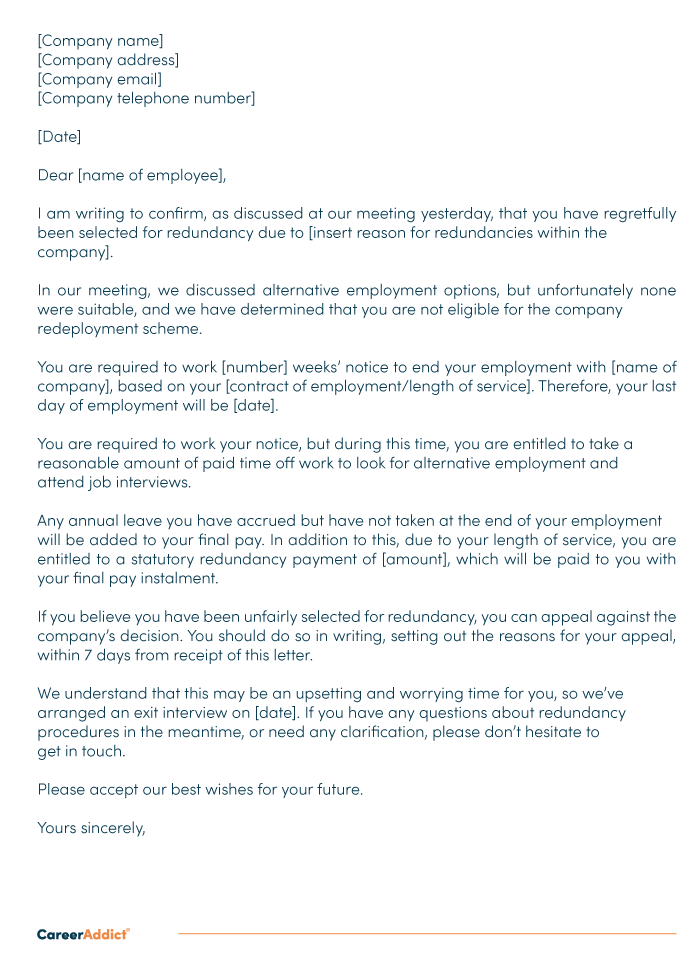Exploring the Interaction In Between Company Redundancy and Organizational Adaptability for Future Development
In the vibrant landscape these days's business globe, the intricate relationship between firm redundancy and business flexibility becomes a critical element for sustained growth and success. Companies typically face the difficulty of striking a delicate balance between keeping a level of redundancy to mitigate dangers and fostering adaptability to react promptly to the ever-evolving market demands. This delicate interplay holds the key to not only enduring in turbulent times but also growing when faced with uncertainty. As we discover the diverse dimensions of this interplay, fascinating understandings into exactly how companies navigate these intricacies to lead the method for future development wait for.
Value of Company Redundancy
Firm redundancy is a vital aspect that enhances business durability and mitigates functional risks. By integrating redundancy actions within the business structure, firms can much better hold up against unforeseen disruptions and fluctuations in business environment. Redundancy offers as a critical buffer, enabling companies to adjust and react successfully to unforeseen difficulties without compromising important operations.
One key aspect of the importance of company redundancy is its duty in making certain continuity during times of crisis. When confronted with unexpected modifications or emergency situations, redundant systems, resources, or workers can action in to keep important features and avoid extensive disturbances. This continuity not just safeguards the company's track record and client trust but also reduces financial losses and operational downtime.

Methods for Business Flexibility

One more important approach is buying technology and infrastructure that can support versatility and scalability. Executing digital devices, automation, and data analytics can enhance operations, improve effectiveness, and give useful insights for educated decision-making. Moreover, creating adaptable business frameworks that permit fast modifications to market characteristics and customer needs is essential for staying competitive in a quickly evolving environment. By proactively recognizing prospective disruptions and possibilities, organizations can proactively thrive and adjust in an ever-changing service landscape.
Balancing Redundancy and Adaptability
Achieving an unified equilibrium between functional redundancy and business versatility is Visit Your URL paramount in navigating the intricacies of a dynamic service environment. Redundancy within a business gives a safeguard, ensuring continuity and security in procedures. Nonetheless, an excess of redundancy can cause inadequacies and hinder adaptability to altering market conditions. On the other hand, business flexibility enables firms to respond without delay to exterior disturbances and confiscate brand-new chances. Striking the best equilibrium in between redundancy and flexibility is a fragile procedure that needs a deep understanding of the company's objectives, sector dynamics, and risk resistance.
To attain this equilibrium, firms require to carry out regular evaluations of their operations to recognize areas where redundancy is needed for danger mitigation and where adaptability can drive development and development. Applying versatile structures, cultivating a society of continuous understanding and renovation, and motivating open communication across all levels of the company are vital approaches to harmonize redundancy and adaptability efficiently. By aligning these 2 crucial elements, firms can place themselves for sustainable growth and success in an ever-changing organization landscape.
Study on Adjustment Success
In checking out instances of successful business adjustment, it ends up being noticeable that the interplay between functional redundancy and adaptability is a defining variable in shaping durable services. One compelling study is that of Netflix. At first a DVD rental service, Netflix showed exceptional adaptability by transitioning right into a streaming platform when digitalization interfered with the market. By strategically purchasing technology and web content development, Netflix not just made it through but grew in a swiftly advancing market. One more standout example is Amazon. Beginning as an on the internet bookstore, Amazon continuously adjusted its organization version, increasing right into diverse sectors such as cloud computing and artificial knowledge. This flexibility permitted Amazon to remain in advance of competitors and fulfill changing customer needs. Finally, Adobe provides a noteworthy picture of effective adjustment. The company changed from offering software application licenses to a subscription-based model, ensuring recurring earnings streams and improved client engagement. These study highlight the importance of functional redundancy combined with organizational adaptability in cultivating long-term growth and competition.
Structure Strength for Future Development
Building strength for future development calls for a calculated positioning of operational procedures with market dynamics and site here emerging trends. Firms have to adjust to altering atmospheres by promoting a society of flexibility, development, and constant enhancement.
Furthermore, promoting solid partnerships with stakeholders, such as clients, employees, suppliers, and the area, is crucial for maintaining and weathering unpredictabilities depend on and support throughout stormy times. Efficient communication and transparency play a vital role in structure strength, as they help facilitate and line up assumptions cooperation in navigating uncertainties.
Moreover, companies need to prioritize discovering and growth initiatives to upskill workers and furnish them with the essential devices to adapt to changing scenarios. By buying their labor force, companies can enhance their versatility and dexterity, inevitably enhancing their durability for lasting future development.
Conclusion

In the dynamic landscape of today's organization world, the complex relationship between firm redundancy and business versatility arises as a vital factor for sustained development and success. Companies commonly face the challenge of striking a fragile equilibrium between preserving a degree of redundancy to mitigate dangers and blog promoting flexibility to respond promptly to the ever-evolving market needs.To attain this balance, firms need to carry out regular analyses of their procedures to identify locations where redundancy is required for danger mitigation and where flexibility can drive development and development.In verdict, the interplay in between firm redundancy and organizational versatility is critical for future growth. Building strength via a combination of redundancy and versatility will certainly guarantee that business are prepared for the obstacles of the future.
Comments on “Who Pays Redundancy Money? Comprehending Company Responsibilities in the UK”